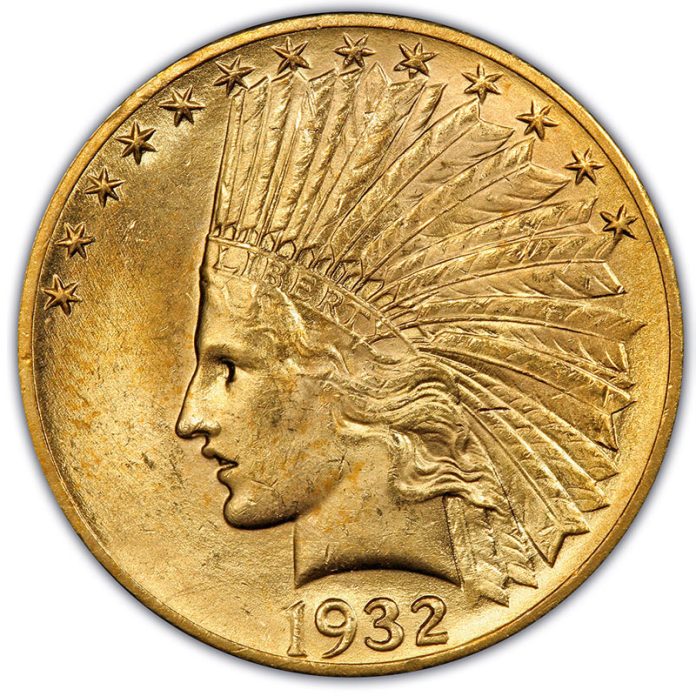
Gift and wish lists for coin collectors are top of mind this holiday season. Here’s a list of magnificent coins worthy of any list, starting with affordable coins and concluding with one aspirational coin.
1. 1943-D Steel Lincoln Head Cent, MS-65. Price: $40
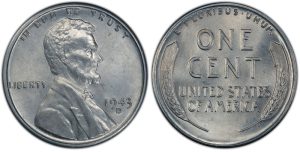
Great amounts of copper were needed for munitions in World War II. As a result, the U.S. Mint was unable to use copper to manufacture the affable Lincoln Head cent in 1943. Instead of using copper, the Mint manufactured these pennies from zinc-coated steel blanks or “planchets.”
When these steel cents were first manufactured, they were all bright and shiny and almost silver in color. However, with the passage of time, these coins can easily corrode, even those graded by a top grading service. Many steel cents have lost their luster and appear a dull gray color. Steel cents were made in the billions so they are easy to find for coin collectors. But Gem steel cents, those grading Mint State-65 or better on that ubiquitous one through 70 scale where one represents a coin so well worn it’s barely identifiable as to its type and 70 is perfect, are hard to locate.
Some of these Gem steel cents have brought tens of thousands of dollars at auction. But a mere MS-65 example graded by the Professional Coin Grading Service (PCGS) will only set you back $40.
As an aside, some of the “copper” or, more technically, bronze planchets made it into the hopper and were used to manufacture a small number of Lincoln Head cents with the 1943 date in error. These coins, when authenticated, are great rarities and can command millions of dollars.
I have this coin set aside for my spouse, Candace, because she is as strong as steel and is the light of my life. She also appreciates frugality.
2. 1909-V.D.B. Lincoln Head Cent, MS-65 Red and Brown. Price: $175
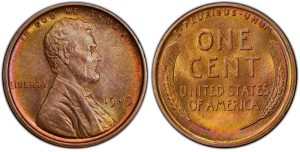
When I was a kid, I went to the bank and got rolls of Lincoln cents hoping to pluck out those earlier cents (bearing the date 1958 and before) that had the wheat stalks on their reverse.
In the early 1980s after engaging in this exercise, I found five 1924-D (Denver Mint) Lincoln head cents. I sold them to coin collectors at a local flea market where I set up a coin booth.
Many people start collecting coins when they find or are given an early date Lincoln Head cent. That’s why one of my favorite holiday gifts is the 1909 V.D.B. Lincoln head cent.
1909 was the first year of issue and as a result, 1909 Lincoln Head cents were saved in quantity by the public because of the novelty of the new design. The highly-sought-after 1909-S V.D.B. Lincoln cent commands the most amount of money for those Lincolns made in 1909.
“S” stands for San Francisco, where the coin was manufactured. And “V.D.B.” stands for the designer’s initials “Victor David Brenner.”
The 1909 Lincoln Head cent bearing the V.D.B. on the reverse, but not the “S” Mint mark on the front or obverse, is valued at $175 in a grade of Gem MS-65 Red and Brown. This makes a wonderful gift because of this coin’s association with the Lincoln cent bearing the “S” which looks just like this coin, but without that “S.” The 1909-S V.D.B. can be worth tens of thousands (sometimes hundreds of thousands) of dollars.
I’ve given some early date Lincoln head cents to coin collectors as gifts years ago, and some of those people who began to collect coins are still collectors today. This is a coin I’d give to my Uncle Bill because he appreciates history, and with 1909 marking the 100th anniversary of Lincoln’s birth, he would appreciate the story behind the coin.
3. 1932 Indian Head Eagle ($10 Gold Piece) MS-62. Price: $2,000
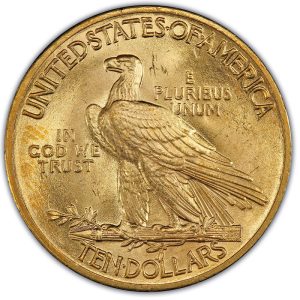
The Indian ten was designed by famed sculptor Augustus Saint-Gaudens, who did not live to see this design implemented, as he died from cancer before the coin was released into circulation by the U.S. Mint. This design is one of my favorite coin designs of all time.
I like the change from the conventional Liberty head to something more creative and artistically significant. And the coin contains nearly a half-ounce of gold.
Many of the Indian tens were transported to European banks. And many of them, although there were lots of sales in the 1970s, are still in Europe.
As a result of the high gold content and magnificent appearance, these coins are quickly snapped up by collectors and investors. High-grade examples can be pricey, but an MS-62 or MS-63 for just a couple of thousand dollars is an appealing buy.
The beauty and gold content makes this a holiday gift that I will give to my mother. I expect the price of gold to rise over the long term and this will supplement her investments beautifully.
4. 1916-S Indian Head Half Eagle ($5 Gold Piece) MS-63. Price: $6,000
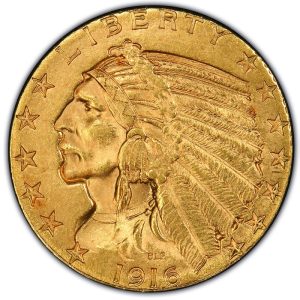
Going from examining the traditional design of the Indian ten to this unusual incuse design Indian five is a startling visual phenomenon. The details are sunk into the fields or background of the coin, and this coin design is only one of two coin types that use this design. The other coin is a $2.5 gold piece, more formally referred to as an Indian Head quarter eagle gold coin.
Indian fives were designed by sculptor Bela Lyon Pratt and manufactured from 1908 through 1929. This was the same period that the quarter eagles of like design were also manufactured.
Most of these coins were never released into circulation for people to spend. In 1933, when gold coins had their manufacture halted, the U.S. Treasury had most of these coins melted. Indian fives, with the exception of 1909-D (Denver Mint), are quite rare in Mint State grades and are very rare in MS-64 or higher grades.
A great middle-of-the-road rarity for an Indian five is the 1916-S (San Francisco Mint). The earlier dates with Mint marks are scarcer and far more valuable in Mint State grades. PCGS reports that it certified a mere 307 in the grade of MS-63, compared with 1,980 in MS-63 for Indian fives bearing the 1908 date (Price: $2,000). I’m quite close with my cousin Ben, and I’ve reserved this coin for him because he’s considering moving West. He’s currently in Chicago.
5. 1930 Standing Liberty Quarter MS-64. Price: $400
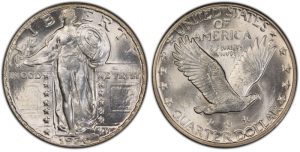
The Standing Liberty Quarter was designed by Hermon A. MacNeil. It’s one of my favorite coins for gift-giving because it has such a magnificent and unique design. The current generation of collectors and investors have rarely ever seen one of these coins, except in coin price guides and history books.
Beginning in 1925, the dates on Standing Liberty quarters were recessed. This gave them protection from being damaged in transit and in circulation. Well-struck examples can be exceptionally valuable, and the focal point is Liberty’s head. “Full Head” examples can command tens of thousands of dollars over their mushy head counterparts. The tiny “M” that appears to the right of the date stands for MacNeil, the designer’s initial.
The late-date non-full-head coins are relatively inexpensive. And since this coin was only manufactured for 13 years, and full sets without expensive varieties are affordable, the Standing Liberty quarter ranks high in popularity for coin collectors and gift-giving.
My Cousin Ryan will be receiving this coin from me as his holiday gift. He lives in Brooklyn, and the strength of the coin’s design, especially the later dates, symbolizes his own strength.
6. 1881-S Morgan Silver Dollar MS-63. Price: $98
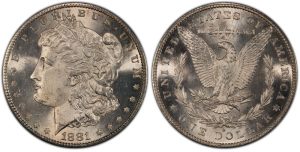
Although the 1881-S Morgan silver dollar graded MS-63 coin nears the end of my list of seven coin gifts, it’s my number one pick as a gift for coin collectors, not just during the holidays, but year-round.
77,985 examples were graded MS-63 by PCGS, and this is conducive to being inclusive. A coin this old and in a Choice Mint State grade (and don’t forget it contains nearly an ounce of silver) is easy for dealers and large-scale marketers to promote to the public and to coin collectors.
The Morgan dollar, named as such for its designer George T. Morgan, ranks as probably the most collected U.S. coin of all time. The fascination with Morgan silver dollars is universal. It was minted from 1878 to 1904, also in 1921, and yet again beginning in 2021.
This coin reminds me of years past when slot machines accepted dollar coins and paid out in silver dollars. It’s an iconic coin that was used for many decades and symbolizes great value.
Even the U.S. Mint recognizes how widely collected Morgan dollars are: In 2021, it re-introduced the Morgan (and Peace) silver dollars to a new generation of eager collectors. Hopes are high that the Mint will continue to issue this coin, even if at sporadic intervals.
The value and beauty here are beyond reproach.
7. 1927-D Saint-Gaudens Double Eagle MS-65+. Price: $3.5 Million
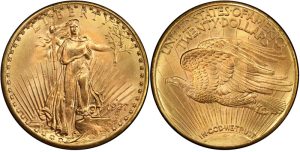
If I were to win the PowerBall, this is the coin I would buy for my ultimate holiday gift. Sorry, friends and relatives. This one would be for me.
There are only 15 to 18 known examples. In the grades of MS-65+ and MS-66, PCGS lists a total of five coins graded. Two specimens are listed with higher grades. So, it’s fair to conclude that this is a monumental, milestone rarity for collectors of Saint-Gaudens double eagles.
A 1927 “Saint” in MS-65+ (no “D” Mint mark) is valued at $3,500. How ironic what one missing Mint mark does for the value of a 1927 gold coin: $3,500 versus $3.5 million.
The design and appearance of all coins in this series are magnificent. Many coin collectors appreciate this coin design for its exquisite artistic and cultural significance, as well as its high gold content.
But if gold loses $100 in value, the impact on this coin is probably… nothing.
Happy holidays!
This article about holiday gifts for coin collectors previously appeared in COINage magazine. To subscribe click here. Article by Curt Mease. All photos courtesy of the Professional Coin Grading Service (PCGS).











